Piccadilly Line
Piccadilly line map.


Piccadilly Line Overview
The Piccadilly Line is a line of the London Underground network which crosses the town of London from the north to the west. It connects the Heathrow Airport and the town of Uxbridge in the western part of the Greater London to Cockfosters, in the north, through the city centre of the English capital city. Around 220,000,000 passengers use the Piccadilly line. It serves 53 stations and has a total length of 44 miles. It is the Dark Blue Line on the Tube map.
London Piccadilly Line Service Status
Tourist attractions on the piccadilly line.
- Trent Park , a beautiful country park with its country house is located in front of Cockfosters tube station.
- The Emirates Stadium , home ground of Arsenal F.C is accessible from Finsbury Park , Arsenal and Holloway Road .
- The British Museum , which is the most visited museum of the United Kingdom, dedicated to culture and art, is served by both Russel Square and Holborn stations.
- Lincoln’s Inn Fields , the biggest and one of the most popular public squares in London, and Sir John Soane’s Museum , dedicated to the work of the famous English neo-classical architect, are located close to Holborn Underground station.
- Leicester Square , a popular green square famous for hosting events during the Chinese New Year, is accessible from Leicester Square station.
- Piccadilly Circus , the public square famous for its buildings with giant video and neon advertisements, is served, as its name indicates, by Piccadilly Circus tube station.
- Green Park , one of the Royal Parks of London, and Buckingham Palace , the London residence of the British Royal Family, are located at walking distance from Green Park station.
- Hyde Park , another Royal Park of London, stands, as its name suggests close to Hyde Park Corner Underground station.
- Harrods and Harvey Nichols , the 2 famous department stores are accessible from Knightsbridge tube station.
- The Natural History Museum , the Science Museum , the Victoria and Albert Museum , the world’s biggest design museum, the Royal Albert Hall , a beautiful concert hall located in front of Kensington Gardens and the Royal College of Music are served by South Kensington Underground station.
- Boston Manor , one of the ancient manors of Middlesex, and its park, are situated next to Boston Manor station.
Piccadilly Line stations
- Cockfosters is the northern terminus station of the Piccadilly Line. Travelcard Zone 5.
- Oakwood station is located in the area of Oakwood which gives it its name. Travelcard Zone 5. Wheelchair accessible.
- Southgate tube station is located in the suburban area of London which holds the same name. Travelcard Zone 4.
- Arnos Grove tube station is located, as its name indicates, in the area of Arnos Grove. The station building is listed Grade II*. Travelcard Zone 4.
- Bounds Green Underground station is located in the area which gives it its name. Travelcard Zone 3-4.
- Wood Green station is located in the popular residential area of Wood Green, as its name indicates. Travelcard Zone 3.
- Turnpike Lane tube station is located in Haringey, on the street of Turnpike Lane. Travelcard Zone 3.
- Manor House station is located in the district which holds the same name. Travelcard Zone 2-3.
- Finsbury Park is located at walking distance from the Emirates Stadium, home of Arsenal FC. Travelcard Zone 2.
- Arsenal is the closest Underground station from the Emirates Stadium, which is accessible from there too. Travelcard Zone 2.
- Holloway Road tube station is located in the district of Holloway. It is also very close to the Emirates Stadium. Travelcard Zone 2.
- Caledonian Road station also stands in Holloway, on the road which gives it its name. Travelcard Zone 2. Wheelchair accessible.
- King’s Cross St. Pancras station is one of the biggest interchange complexes in London. It is connected to both London King’s Cross and St. Pancras International railway stations. Travelcard Zone 1. Wheelchair accessible.
- Russell Square Underground station stands in Bloomsbury, on Bernard Street. It is located close to the British Museum. Travelcard Zone 1.
- Holborn tube station is located at the corner of Kingsway and High Holborn in Central London. Travelcard Zone 1.
- Covent Garden station stands at the corner of James Street and Long Acre, in the City of Westminster. Travelcard Zone 1.
- Leicester Square tube station is situated on Charing Cross Road, very close to the pedestrian square of the same name. Travelcard Zone 1.
- Piccadilly Circus station is located under Piccadilly Circus, whoch gives the name to the station and to the line. Travelcard Zone 1.
- Green Park Underground station is located very close to the Royal Park of London which holds the same name. It also serves Buckingham Palace. Travelcard Zone 1. Wheelchair accessible.
- Hyde Park Corner station, as its name indicates, stands at the southeastern corner of Hyde Park. Travelcard Zone 1.
- Knightsbridge is located in the shopping area which gives it its name, where stand both Harrods and Harvey Nichols department stores. Travelcard Zone 1.
- South Kensington tube station is situated in the district of Kensington. There are many important museums nearby. Travelcard Zone 1.
- Gloucester Road station stands at the corner of Gloucester Road and Cromwell Road, in Kensington. Travelcard Zone 1.
- Earl’s Court Underground station is located in the district which holds the same name. Travelcard Zone 1-2. Wheelchair accessible.
- Barons Court tube station is located in West Kensington. Travelcard Zone 2.
- Hammersmith station stands in the district which gives it its name. Travelcard Zone 2. Wheelchair accessible.
- Turnham Green Underground station is situated in the district of Chiswick, West London. Travelcard Zone 2-3.
- Acton Town station stands in the area of Acton, which gives it its name. Travelcard Zone 3. Wheelchair accessible.
- South Ealing tube station is located in the suburban district of Ealing. Travelcard Zone 3.
- Northfields station is situated in the residential area which holds the same name. Travelcard Zone 3.
- Boston Manor Underground station is located in the area of the Boston Manor, as its name indicates. Travelcard Zone 4.
- Osterley station stands in the suburban area of Osterley, which gives it its name. Travelcard Zone 4.
- Hounslow East is one of the 3 stations on the line located in the town of Hounslow. Travelcard Zone 4. Wheelchair accessible.
- Hounslow Central Underground station is also located in Hounslow. Travelcard Zone 4.
- Hounslow West is the third station situated in the town of Hounslow. Travelcard Zone 5. Wheelchair accessible.
- Hatton Cross tube station stands in the small residential area of Hatton. Travelcard Zone 5-6.
- Heathrow Terminal 4 station serves, as its name indicates, the terminal 4 of Heathrow Airport. Travelcard Zone 6. Wheelchair accessible.
- Heathrow Terminals 2 & 3 serves terminal 2 and 3 of Heathrow Airport. It previously also served terminal 1, now closed. Travelcard Zone 6. Wheelchair accessible.
- Heathrow Terminal 5 tube station is the southwestern terminus station of Piccadilly Line. It serves the terminal 5 of Heathrow Airport. Travelcard Zone 6. Wheelchair accessible.
- Ealing Common station is, as its name indicates, located in the area of Ealing Common. Travelcard Zone 3.
- North Ealing Underground station is situated in the London Borough of Ealing. Travelcard Zone 3.
- Park Royal tube station stands close to the industrial and business area of Park Royal, which gives its name to the station. Travelcard Zone 3.
- Alperton station, at its name suggests, is located in the area of Alperton. Travelcard Zone 4.
- Sudbury Town station is located in the suburban area which gives it its name. Travelcard Zone 4. Wheelchair accessible.
- Sudbury Hill is also located in Sudbury. Travelcard Zone 4.
- South Harrow tube station is situated in the area which holds the same name. Travelcard Zone 5.
- Rayners Lane Underground station stands in the district of Rayners Lane. Travelcard Zone 5.
- Eastcote station is located in the suburban area which gives it its name. Travelcard Zone 5.
- Ruislip Manor tube station is situated in the area which shares the same name. Travelcard Zone 6.
- Ruislip Underground station is located in the town of Ruislip. Travelcard Zone 6.
- Ickenham station stands in the area which holds the same name. Travelcard Zone 6.
- Hillingdon tube station is located in the suburban area which gives it its name. Travelcard Zone 6. Wheelchair accessible.
- Uxbridge station is the western terminus station of the Uxbridge branch of the Piccadilly Line. Travelcard Zone 6. Wheelchair accessible.
The Piccadilly Line serves different important transportation sites
- Heathrow Airport is served by 3 different tube station on Piccadilly Line. Terminals 2 and 3 are served by the station which holds the same name, terminals 4 and 5 are served by 2 additional stations.
- London King’s Cross is one of the 2 railway stations served by King’s Cross St. Pancras tube station. You can there a train to the northern part of England, and to Scotland.
- St Pancras International is the other station connected to King’s Cross St. Pancras Underground station. You can travel there to Paris or Brussels with the Eurostar.
The Piccadilly Line is connected to the following London Underground lines
- Victoria Tube Line at Finsbury Park.
- Circle Line , Hammersmith & City Line , Metropolitan Line , Northern Tube Line and Victoria Line at King’s Cross St. Pancras.
- Central Line at Holborn.
- Northern Tube Line at Leicester Square.
- Bakerloo Tube Line at Piccadilly Circus.
- Jubilee Tube Line and Victoria Line at Green Park.
- Circle Tube Line and District Line at South Kensington and Gloucester Road.
- District Line at Earl’s Court, Barons Court, Hammersmith, Turnham Green, Acton Town and Ealing Common.
- Metropolitan Tube Line at Rayners Lane, Eastcote, Ruislip Manor, Ruislip, Ickenham, Hillingdon and Uxbridge.
Ticket Price
Piccadilly line timetable.
The Piccadilly line runs every day of the week including saturdays, sundays and holidays.
First Service
The first service leaves Cockfosters Underground station at 5:09 from Monday to Saturday , and at 7:00 on Sundays , Heathrow Terminal 5 Underground station at 5:23 from Monday to Saturday , and at 6:07 on Sundays , Heathrow Terminal 4 Underground station at 5:02 from Monday to Saturday , and at 5:46 on Sundays and Uxbridge at 6:20 from Monday to Friday and at 8:43 on Saturdays and Sundays .
Last Service
The last service leaves Cockfosters Underground station at 23:54 from Monday to Saturday , at 23:00 on Sundays , Heathrow Terminal 5 Underground station at 23:42 from Monday to Saturday , and at 23:25 on Sundays , Heathrow Terminal 4 Underground station at 23:35 from Monday to Saturday , and at 22:37 on Sundays and Uxbridge at 23:04 from Monday to Saturday and at 22:04 on Sundays .
You can find the full Piccadilly line timetable on the TFL website.
Times, Timetables, Maps, Info, Stuff.

Piccadilly Line Stations & Tube Map
Piccadilly line tube map, a list of piccadilly line stations.
This is a list of all Piccadilly Line stations from Cockfosters to Uxbridge.
Cockfosters Oakwood Southgate Arnos Grove Bounds Green Wood Green Turnpike Lane Manor House Finsbury Park Arsenal Holloway Road Caledonian Road King’s Cross St. Pancras Russell Square Holborn Covent Garden Leicester Square Piccadilly Circus Green Park Hyde Park Corner Knightsbridge South Kensington Gloucester Road Earl’s Court Barons Court Hammersmith Turnham Green Acton Town Ealing Common North Ealing Royal Park Alperton Sudbury Town Sudbury Hill South Harrow Rayners Lane Eastcote Ruislip Manor Ruislip Ickenham Hillingdon Uxbridge
This is a list of all Piccadilly Line stations from Cockfosters to Heathrow Terminal 4.
Cockfosters Oakwood Southgate Arnos Grove Bounds Green Wood Green Turnpike Lane Manor House Finsbury Park Arsenal Holloway Road Caledonian Road King’s Cross St. Pancras Russell Square Holborn Covent Garden Leicester Square Piccadilly Circus Green Park Hyde Park Corner Knightsbridge South Kensington Gloucester Road Earl’s Court Barons Court Hammersmith Turnham Green Acton Town South Ealing Northfields Boston Manor Osterley Hounslow East Hounslow Central Hounslow West Hatton Cross Heathrow Terminals 1,2,3 Heathrow Terminal 4
Navigating the Iconic London Underground: Unveiling the Wonders of the Piccadilly Line
Beneath the bustling streets of London lies an intricate network of underground railways, transporting millions of commuters and tourists every day. Amongst these lines, the Piccadilly Line stands out as one of the most iconic and historic routes. Spanning across the capital, it weaves through the city, connecting vibrant neighbourhoods, historical landmarks, and cultural hotspots. Join us as we embark on a captivating journey along the Piccadilly Line, discovering its rich history, architectural wonders, and unrivalled connectivity.
The Birth of an Icon: Origins and Evolution
The Piccadilly Line, a testament to London’s engineering prowess, had its humble beginnings in the early 20th century. Officially opening in 1906, the line initially connected Finsbury Park and Hammersmith. Over the years, the line expanded its reach, evolving into the extensive route we know today.
Its distinctive name is derived from the Piccadilly area, famous for its fashionable ties to the textile trade during the 17th century. The Piccadilly Line not only connects these historical roots but also extends its branches to other significant parts of London, including Heathrow Airport, making it a crucial link for both locals and visitors.
Architectural Marvels Underground: Exploring Stations along the Line
As you journey through the Piccadilly Line, you’ll encounter a stunning array of architecturally diverse stations. Each station tells its own unique story, blending history with contemporary design.
One such gem is Covent Garden station, nestled in the heart of the vibrant West End. Its distinctive red tiled façade, originally designed to match the nearby market’s aesthetic, has become an iconic symbol. Step inside, and you’ll find yourself surrounded by elegant wrought iron and tiled motifs, transporting you back to an era of Victorian grandeur.
Moving westward, the line’s next architectural delight awaits at Arnos Grove station. Designed in the 1930s by the prominent architect Charles Holden, its streamlined and geometric style is a hallmark of the Art Deco movement. The station’s spacious ticket hall, adorned with decorative panels and carefully crafted lighting fixtures, showcases the meticulous attention to detail that characterizes Holden’s work.
A Journey Through Time: Historical Landmarks Along the Line
The Piccadilly Line acts as a gateway to some of London’s most treasured historical landmarks. Hop off at King’s Cross St Pancras station, and you’ll find yourself within reach of two iconic sites: the British Library and St Pancras International. The British Library houses a vast collection of literary works, including historic manuscripts and renowned treasures like the Magna Carta. St Pancras International, a marvel of Victorian Gothic architecture, stands proudly as a symbol of the city’s rich heritage.
Venturing further along the line, another historical marvel awaits at South Kensington station. Alight here to explore the world-famous museums of Exhibition Road, including the Victoria and Albert Museum, the Natural History Museum, and the Science Museum. Immerse yourself in the realms of art, culture, and science as you wander through their captivating exhibitions and collections.
Unleashing the Shopper’s Paradise: Retail Therapy along the Line
For those seeking retail therapy, the Piccadilly Line offers access to a plethora of shopping destinations. Embark at Knightsbridge station, and you’ll find yourself at the doorstep of the world-renowned Harrods. Explore its lavish halls, brimming with luxury goods and designer brands, tempting even the most discerning shoppers.
If you’re in search of a more eclectic shopping experience, alight at Hammersmith station. Just a short walk away, you’ll discover the bustling King Street, lined with a vibrant mix of high-street shops, independent boutiques, and quaint cafes. Lose yourself in the maze of unique offerings, from vintage treasures to contemporary fashion.
Cultural Delights: The Piccadilly Line’s Artistic Connection
Prepare to be enthralled by the artistic wonders that await you along the Piccadilly Line. As you journey through this iconic underground route, you’ll encounter a captivating fusion of art and transit, where stations themselves become galleries showcasing remarkable artworks.
On our journey, we arrive at Southgate station, where a visual feast awaits. Cyril A. Farey’s enchanting murals adorn the station, captivating passengers with scenes from local history and folklore. The skillfully crafted panels transport viewers to bygone eras, revealing the essence of the community’s heritage. As you wander through the station, take a moment to immerse yourself in these narrative artworks, appreciating the intricate details and the stories they tell.
The artistic connection doesn’t end there. Step off at Arnos Grove station, and you’ll be greeted by Charles Holden’s architectural marvel. This station, with its Art Deco influences, seamlessly merges functionality and aesthetics. The exterior’s elegant curves and geometric patterns hint at the grandeur within. As you descend into the station, be sure to take in the meticulously designed interior, where every corner showcases Holden’s meticulous attention to detail. This fusion of art and architecture creates a harmonious space that transcends the ordinary, turning the act of commuting into an artistic experience.
Beyond the individual stations, the Piccadilly Line itself serves as a canvas for artistic expression. From thought-provoking installations to poetic displays, various forms of art adorn the platforms and corridors. As you traverse the line, keep your eyes open for these artistic interventions that surprise and inspire, adding an extra layer of beauty to your journey through the underground.
The Piccadilly Line’s artistic connection transcends mere transportation. It infuses daily commutes with inspiration, reminding passengers of the power of art to transform spaces and evoke emotions. So, next time you find yourself on the Piccadilly Line, take a moment to immerse yourself in the artistic delights that grace its stations and appreciate the unique marriage of art and transit that makes this underground journey truly unforgettable.
Connectivity Redefined: From Suburban Retreats to International Gateways
Beyond its role as a means of transportation within the city, the Piccadilly Line offers unprecedented connectivity to both suburban retreats and international gateways.
For nature enthusiasts, alight at Oakwood station and venture into Trent Park, a verdant oasis boasting vast woodlands, meandering trails, and even a stately home. It’s the perfect escape from the urban hustle, providing a tranquil respite where you can reconnect with nature.
On the other end of the spectrum, the Piccadilly Line connects directly to Heathrow Airport, serving as a vital link between London and the world. Whether you’re arriving in the city or bidding farewell, this seamless connection ensures a convenient and efficient journey, eliminating the stress of navigating through multiple modes of transportation.
Far more than a mere underground railway
The Piccadilly Line is far more than a mere underground railway. It is a gateway to the essence of London itself, intertwining history, culture, architecture, and connectivity in a remarkable tapestry. As you traverse its tracks, you’ll uncover the city’s treasures, from iconic landmarks to hidden gems, all seamlessly connected beneath the bustling streets.
So, next time you find yourself in London, take a voyage along the Piccadilly Line and immerse yourself in its rich tapestry of experiences. From the architectural marvels of Covent Garden and Arnos Grove to the historical landmarks of King’s Cross and South Kensington, from the retail paradise of Knightsbridge to the artistic gems of Russell Square and Southgate, this iconic underground route promises an unforgettable journey through the heart of London.
Keep Informed...

Receive irregular news, post notifications and information!
Check your inbox or spam folder to confirm your subscription.
Cookie Settings
Privacy overview.
Map of the Piccadilly Line
Welcome to the official site for the London Piccadilly Line maps. This iconic dark blue line serves as a vital link between West and North London. Notably, in the west, it features two branches that converge at Acton Town station.
The Piccadilly Line also boasts stations at Heathrow International Airport, offering the quickest transit option to Central London. Additionally, it passes near another key London landmark – Buckingham Palace. For visiting the Palace, alight at Hyde Park Corner station.
List of Piccadilly Line maps
See the stations on the map below (May 2024).
→ Click map to zoom ←
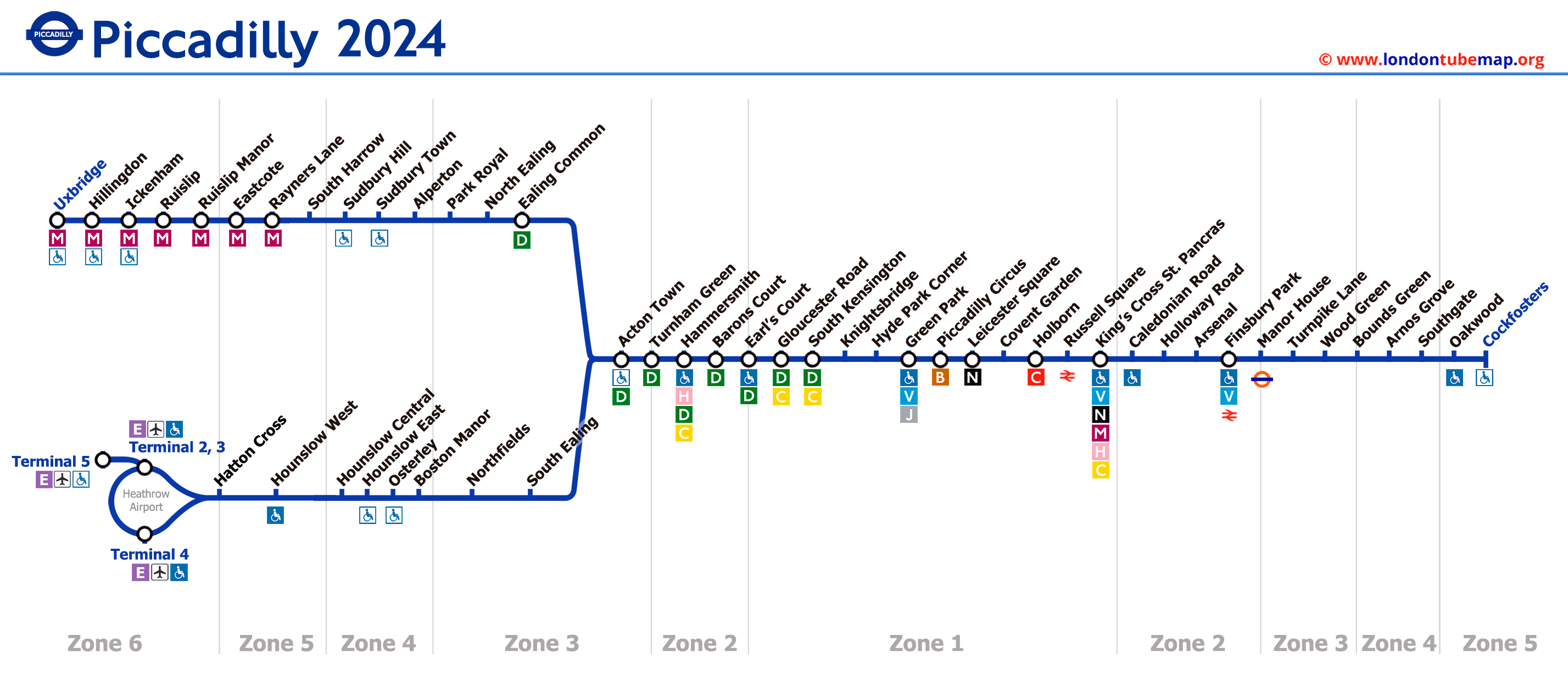
Overview of this tube line:
- Opened in 1906.
- Colour: Dark blue.
- Underground.
- 53 stations.
- 71 km (44 miles) long.
Should you wish to explore the entirety of the London Underground network, you are invited to view the comprehensive London Tube map . This resource includes a page where all lines are neatly presented together (yet distinctly separate) , or you may opt to examine individual lines simultaneously.
Airport Routes
Travelling between terminals at Heathrow Airport using the Piccadilly Line might seem a bit daunting, so here's a simplified table summarizing the connections between terminals using the Piccadilly Line. All these inter-terminal journeys at Heathrow Airport are free with an Oyster card or contactless payment.
Piccadilly line stations and routes
The Piccadilly line currently has 3 different routes, so before boarding, it is important to look carefully at the front of the train and check the sign with the name of the destination to avoid getting onto the wrong Tube train.
If you click on the name of the station, you can see real-time timetable information and more detailed info. If you click on the line icons, you will see information about that line and its transfers.
Route 1: Heathrow Terminal 4 - Cockfosters
Reverse route view
Route 2: Heathrow Terminal 5 - Cockfosters
Route 3: uxbridge - cockfosters.
London tube map | Timetable | Fares | All subway lines
TfL Piccadilly underground
Tfl piccadilly underground stop list and next departures.
The TfL Piccadilly - Piccadilly underground serves {count_of_stops} underground stops in the London area departing from {first_stop} and ending at {last_stop}. Scroll down to see upcoming Piccadilly underground times at each stop and the next scheduled Piccadilly underground times will be displayed. The full Piccadilly underground schedule as well as real-time departures (if available) can be found in the app .
The TfL Piccadilly - Piccadilly underground route map is shown above. The route map shows you an overview of all the stops served by the TfL Piccadilly underground to help you plan your trip on TfL. Opening the app will allow you to see more detailed information about the route on a map including stop specific alerts, such as stops that have been closed or moved. You can also see the location of vehicles in real-time on the route map so you know when the Piccadilly underground is approaching your stop.
TfL Piccadilly underground Service Alerts
Open the app to see more information about any active disruptions that may impact the Piccadilly underground schedule, such as detours, moved stops, trip cancellations, major delays, or other service changes to the underground route. The app also allows you to subscribe to receive notifications for any service alert issued by TfL so that you can plan your trip around any active or future disruptions.
TfL Piccadilly underground FAQ
What time does the next tfl piccadilly underground depart from {first_stop}.
The next Piccadilly underground leaves {first_stop} at {first_stop_first_time}, and arrives at {last_stop} at {last_stop_first_time}. The total trip time for the next TfL Piccadilly underground is {number_of_minutes} minutes.
Is the TfL Piccadilly underground running on time, early or late?
You can track your underground on a map, monitor real-time updates, and see adjustments to the TfL Piccadilly schedule by downloading the app .
When does the next TfL Piccadilly underground arrive?
You can see the next TfL Piccadilly underground times in the app as well as future departure times for the Piccadilly underground.
How many underground stops are there for the TfL Piccadilly underground?
There are {count_of_stops} stops on the TfL Piccadilly underground.
Is the TfL Piccadilly underground usually crowded?
You can find real-time information on TfL Piccadilly underground crowding levels in the app (available in select cities or on select trips). You can also see predictions on how crowded the underground will be when it gets to your underground stop.
Is the TfL Piccadilly underground currently running?
Find out the current status for the TfL Piccadilly underground in the app .
What is the closest TfL Piccadilly underground stop to me?
Open the app to see your location on a map and find the closest Piccadilly underground stop to where you are.
Other TfL underground schedules, routes and maps
- Bakerloo Bakerloo
- Central Central
- Circle Circle
- District District
- Hammersmith & City Hammersmith & City
- Jubilee Jubilee
- Metropolitan Metropolitan
- Northern Northern
- Victoria Victoria
- Waterloo & City Waterloo & City
Other transit modes in London area
Never miss your underground again. download transit..
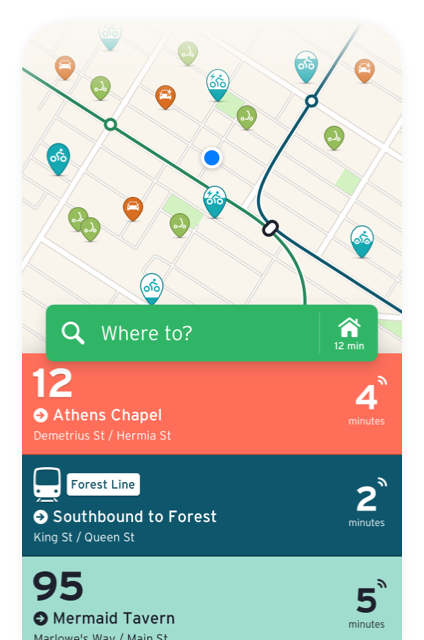

Route Planner
Alternative Route
Station information, piccadilly line, route and journey times.
Cookie Consent
A1 Publishing Ltd and our advertising partners would like the opportunity of serving you with personalised ads. In order to do so we need your consent. By giving consent we may set various cookies in order to identify you and or your traits thus allowing us to provide more relevant advertising. Otherwise you will be presented with contextual or random ads only and no personal data will be saved.

- Places to Visit
- Sightseeing
- Practical Tips
- Where to Stay
How to use the London Underground
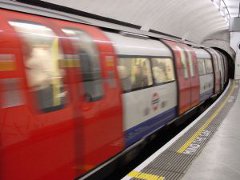
Despite Londoners’ moans, it’s a good service considering it’s the world’s oldest underground system.
There are 12 separate colour-coded lines (including the Docklands Light Railway) that run in northbound, southbound, eastbound or westbound directions.
You’re never far from an underground station in central London – they’re pretty easy to spot.
The new Elizabeth line is actually a train running east to west through central London.
Tube maps and journey planners
View a Tube map or download a PDF version .
Free pocket-sized tube maps are available from underground stations.
The TFL Go app has a ‘live’ tube map, which makes it easy to locate your closest tube station (if location services is turned on), and find the next departure times.
The CityMapper app has a tube map which shows the zones.
Journey planners
If you can’t work out which route to take by looking at the tube map, or if you want door-to-door instruction, see our guide to planning journeys in London .
How to find the right platform
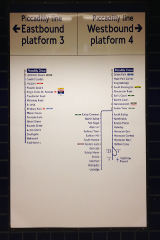
The direction will normally be obvious by looking at the tube map, but if it’s not — here’s what to do:
- Before going through the ticket barriers, or just after the barriers at some stations, look at the destinations list signs to find the tube station you’re travelling to.
- Your destination will be listed on a sign that gives you the direction (eastbound, westbound etc.) at the top.
- Follow the signs and check you’re on the right platform by looking at the destination list on the platform wall.
If you do travel the wrong way, don’t worry, just get off the train and change platform. You won’t pay anything unless you go through the ticket barriers and leave the station.
Some lines have different branches. For example, the westbound Piccadilly line goes to Heathrow, Rayner’s Lane or Uxbridge. Check the display on the platform to make sure you take the right train. You don’t want to end up in Rayner’s Lane if you’re catching a flight from Heathrow.
Tube timetables
The tube does not run to a strict timetable during the day, but you won’t wait long. Most tube trains within central London run every few minutes or so.
If you need more precise information on departure or arrival times, the TfL Journey Planner has a ‘leaving’ or ‘arriving’ option.
Tube first and last times
The first tube trains start running from around 5.00–5.30am. The last tube trains leave central London around 12.30am (see the Night Tube below). Most trains start at least an hour later on Sundays.
The exact start and finish times vary according to each individual underground line. Posters at tube stations give the first and last train times from that station. Alternatively, check the tube timetables on the TfL website for the exact times.
If you need to travel after the tubes have finished, take a bus . Some routes run for 24 hours. If they don’t, there are special night buses.
The Night Tube
There is currently a 24-hour service on Fridays and Saturdays on the following lines:
Some stations on these lines are not served, so check the TfL website before travelling.
The rush hour
There is a morning and evening peak on the underground when the tube trains, tube stations and platforms are extremely busy. The peak times for travel are roughly 7.45am–8.30am and 5.00pm–7.00pm Monday–Friday.
During these busy times you won’t have much room to stand and you definitely won’t find a seat, especially in central London. If you can, wait until after 9.30am before starting your journey.
The TfL Go app tells you if a station is busy or quiet.
Check for delays
You can check if the underground is working normally or if there are any delays on certain lines on the status updates section of the TfL website.
Check for planned engineering work at the weekend
The underground network is being modernised. Engineering work is carried out at weekends and Bank Holidays and sometimes whole sections of the tube are out of action.
When this happens, a replacement bus service run and underground tickets/passes/oyster cards are accepted on the bus. The replacement buses follow the route of the underground line, stopping outside each station, but it might be quicker to travel to your destination by another bus route.
Check TfL’s service update if you travel by tube or the ELizabeth line at the weekend, especially if you plan to travel to or from Heathrow airport.
Related pages
- Guide to London transport tickets and passes
- Underground tickets and Travelcards
- Oyster cards
- Contactles cards
Last updated: 14 February 2023
Getting around London
- How to use the London underground
- How to use London buses
- London cycle hire scheme
- Walking in London
- London trains
- London taxis & minicabs
Useful information
- Plan your journey
- London transport zones
Copyright 2010-2023 toptiplondon.com. All rights reserved. Contact us | Disclaimer | Privacy
London and Beyond: The Piccadilly Line
The piccadilly line serves many of london's most popular attractions, including buckingham palace, british museum, and hyde park. join us as we take you through its history.
By TfL Corporate Archives
Map of Great Northern, Piccadilly and Brompton Railway with Connections (1904-06-05) by Great Northern, Piccadilly and Brompton Railway TfL Corporate Archives
The Piccadilly line opened on Saturday 15 December 1906 between Finsbury Park and Hammersmith. At a length of 9 miles it was the longest tube line in London
Underground Map 1922 (1922-03-01) TfL Corporate Archives
A short branch from Holborn to Strand was opened on 30 November 1907. The station was renamed Aldwych in 1915, and you can see the branch in this iconic Macdonald Gill map from 1922
Aldwych Station (1994-09-22) TfL Corporate Archives
Filming Location
The Aldwych branch was eventually closed in 1994. It's since been seen on screen in TV shows such as Luther and Sherlock, and films such as Darkest Hour and Fast & Furious 6!
The New Underground Station at Piccadilly Circus (1929) TfL Corporate Archives
Demand grew enormously on the line after WWI
In 1907 Piccadilly Circus saw 1.5 million passengers, and by 1922 this had grown to 18 million. The station was upgraded from 1925-1928 with a design by the architect Charles Holden
Map of Northern Extension of Piccadilly Line (1929-11-01) by Underground Electric Railways TfL Corporate Archives
The line was extended again until the 1930s: to the north the line was extended to Cockfosters. This map from 1929 shows the planning stage for the northern extension
Track Plan of Western Extension of Piccadilly Line (1035-06-15) by London Passenger Transport Board TfL Corporate Archives
The line was also extended to the west to South Harrow, Uxbridge, and Hounslow West. The journey from Uxbridge to Cockfosters was at the time the longest electric journey then operated by the Underground
Right royal occasion on the Piccadilly line (1978-01-06) TfL Corporate Archives
"Fly the Tube"
An extension to Heathrow was first raised in 1956, and eventually approved in 1970. The line to Heathrow Central was opened by Queen Elizabeth II in 1977, making London the first city in the world to have its main airport directly connected to its main transport infrastructure
Estimated Modal Split of Airline Passengers using Heathrow Airport (1978-06-15) by London Transport Executive TfL Corporate Archives
This diagram from 1979 shows the change in passenger behaviour when travelling to Heathrow from before and after the extension opening
Underground Map 1979 (1979) by London Transport Executive TfL Corporate Archives
Underground Map Showing Toilets (2023-08-03) by Transport for London TfL Corporate Archives
A fourth terminal opened at Heathrow, leading to a further extension of the line to Terminal 4 in 1984. In 2008 Heathrow opened Terminal 5, with the Piccadilly line extension opening on the same day
Out and About on the Piccadilly Line (2021-10-01) TfL Corporate Archives
The line now connects some of the most famous landmarks in the capital, as demonstrated by this 2012 poster produced for the year of the London Olympic Games
Did you know? The shortest distance between adjacent stations on the Underground is on the Piccadilly line between Leicester Square and Covent Garden, at 0.26 km.
Story compiled by TfL using information in records at the Transport for London Corporate Archives. The Corporate Archives seeks to preserve and make accessible records, not to interpret them. A wider range of material is available for physical consultation. Permission is granted to reproduce for personal and educational use only. This story has been enhanced using images from the collections of the London Transport Museum. All enquiries regarding those images should be made directly to that institution.
TfL in Five Facts
Tfl corporate archives, gardens on the underground, london transport museum, 10 map tales, marvellous moquette, the 11 lines of london, reimagining historic posters, welcome to tfl, meet the designers behind some of london transport's most famous winter posters, introducing london overground, sherlock to st paul's: tiles on the underground.
This website uses cookies to improve your browsing experience and analyze the use of the website. Learn More

How to Use the London Underground

Similar to the New York Subway or the Paris Metro, the London Underground is London's series of (largely) underground trains that run a regular service throughout the city.
Since the trains underground run through a series of tunnels, many people (Londoners and visitors alike!) refer to it as the "tube."
Despite this name, a lot of the London Underground network is above ground when you travel, particularly outside of central London.

The London Underground has 11 lines that serve Greater London, intersecting with each other in the centre of town.
The tube map is divided into nine zones, with Zone 1 being the centre of London, and Zone 9 being the suburbs.
The cost it takes to travel depends on which zone(s) you travel in, and how far your journey will take you.
It also connects to the London Overground (a suburban train line that doesn't run through the centre of town), the new Elizabeth Line (a high-frequency rail service that covers both central London, Heathrow Airport, and the suburbs), and National Rail Services (standard train lines that run throughout the country).
The Underground also connects to other rail services that serve the capital such as the Docklands Light Railway (an aboveground small train line that serves the docklands area).
WHEN DOES THE UNDERGROUND RUN?
In general, the Underground trains run from around 5:00 - 5:30 am until the last train leaves around Midnight, (exact times will vary and are listed on the Transport for London website ).
However, there are Night Tube services that run on some of the lines on Fridays and Saturdays for convenient travel on the weekends.
The Night Tube runs on parts of the Central, Jubilee, Northern, Piccadilly, and Victoria lines only.
- Tickets, Fares, and Oyster Cards
- The Tube Map
- Operating Hours
- Tips from Locals
- to/from Heathrow Airport
- Tourist Buses vs. the Tube
LONDON UNDERGROUND TICKETS AND OYSTER CARDS
Buying a ticket for the London Underground is pretty straightforward, but for most visitors, using a contactless payment card is the best payment method.
So, for a more in-depth explanation, including the cheapest ways to travel, check out our previous post about ticket prices and options here in London. Below is our summary.
There are 4 ways to pay for your rides on the Tube:
- Paper tickets
- Oyster Cards
- Contactless Credit/Debit Cards
We normally recommend avoiding paper tickets and recommend that you buy yourself an Oyster card, unless you have a contactless credit or debit card.
Rides with an Oyster Card or contactless card are much cheaper than paper tickets.
You can add as much money to these as you wish and there is a daily limit that you will spend, (£8.10 for Zones 1-2) so the rides get cheaper the more you use them. The same daily cap applies to your contactless card, too.
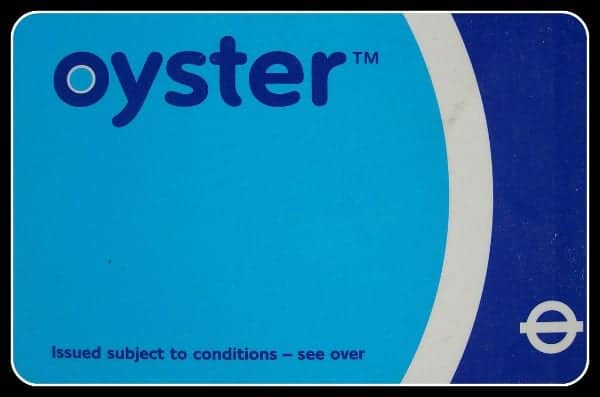
Read our post on which London Oyster Card or Travelcard to buy .
TIP: The Oyster Card is actually included with the London Turbo Pass at no extra cost. If you're planning to visit several notable attractions in the city, this could be a great way to save some money.
London Underground Fares
While there are 6 travel zones for the London Underground, most visitors to London will travel largely within Zones 1 + 2.
How much you pay depends on when you travel, whether during peak hours (06:30 - 09:30 and 16:00 - 19:00 Mon-Fri) vs. off-peak (all other times).
It also depends on where you travel to and from, and whether you are using a paper ticket vs. an Oyster, Travelcard, or contactless credit/debit card.
If you have one of the latter, then you will pay somewhere between £2.70 and £3.00 per ride within Zones 1 + 2.
The most expensive ride (Central London to Heathrow) will cost either £3.30 (off-peak) or £5.60 (peak).
Oyster and Travelcards can be used on all of London's public transportation options, including buses, DLR, the Overground, suburban trains (within London), a water taxi, and even a gondola.
Daily Limits
If you use an Oyster Card or a Contactless Card, then there are daily limits to what you will spend. These caps are dependent on where you are traveling within.
So, for example, if you stay within Zones 1 and 2, the cap for an adult is just £8.10 for the Underground and £5.25 for buses.
So, the more you ride, the cheaper each ride is. You can see what the cap is for each zone or between zones here.

Child Offers
Children under 11 travel for free and there is a 50% off on Oyster Card fares for children 11-15 years of age.
To receive this offer, you need to grab a Tube staff member at any Underground station, including Heathrow.
We help you determine which type of card or ticket you need in our in-depth post on Oyster Cards .
Travelcards
Travelcards are prepaid cards that give you unlimited access to specific zones within London.
You can choose to either order these in advance (in which case you will be given a paper Travelcard) or you can buy them upon arrival (in which case you will be using a plastic Oyster Card with the Travel Card loaded onto it).
Travelcards particularly have benefits for travellers here for an entire week. A 7-Day Travelcard can be worth your while, as a 7-Day Travelcard for Zones 1-2 is £40.70 which works out less per day than the £8.10 daily cap.
Find out more on our post comparing Oyster Cards, Visitor Oyster Cards and Travelcards .
UNDERSTANDING THE TUBE MAP
Picking up a Tube map is easy! They are available for free at most stations on the Underground network.
The maps on offer at the stations are small – perfect for carrying around in your pocket.
Below is a map of the London Underground. You could also download a PDF version .

Don’t be embarrassed to consult your map as you travel through London, even Londoners themselves occasionally need to check where it is they are heading to!
Some people will actually have an app on their phone sporting the London Underground tube map – though we think Google Maps App is very good.
If you look closely at the map, you will notice that the center part is shaded white (zone 1) with a ring of gray shade (zone 2) which is also surrounded by white again (zone 3).
Again, most visitors to London will spend much, if not all, of their time in Zones 1-2.
Focus on Colours
Every line on the London Underground has a different name and colour.
The names and colours will appear on your Tube Map, and also all over the various stations on the network.
For some, memorising the names is easier, but in general, colours can be the simplest way to learn your way around, and also to use when asking for/receiving directions.
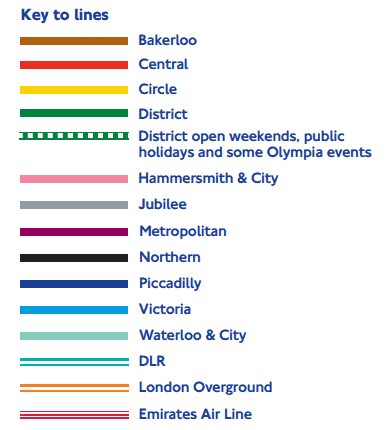
Generally speaking, any particular line will either head north-south or east-west.
FREE TOURS BY FOOT TIP:
Start your holiday in London with our All-in-One London Tour, which takes in most of London's legendary tourist sites and utilizes the London Underground. Get a tutorial directly from us.
OPERATING HOURS AND THE NIGHT TUBE
It’s important to remember that the London Underground system doesn’t run 24 hours a day every day and that timings may be different on weekdays vs. weekends.
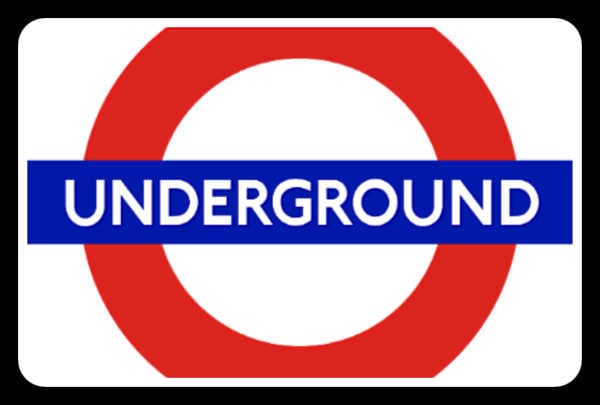
General Hours
Although each station has different timings, in general, the first tube trains start running around 5:00 am - 5:15 am and finish around 12:00 am - 12:30 am from Mondays through Fridays.
On Sundays, the Tube begins a bit later, around 6:00 am - 6:15 am and the final trains depart around 11:30 pm - 12:30 am.
Sundays also carry a reduced service which means there are not as many trains running as on Mondays to Saturdays.
Weekdays: 7:00 am - 9:30 am and 16:00 (4 pm) - 19:00 (7 pm).
Like any major city, London has a very busy rush hour in the mornings and in the evenings when the majority of people are travelling to and from work.
If possible, try to avoid travelling on the tube during these times, particularly if you have any large baggage/luggage with you.
Space is an absolute premium, which means you may have to wait as multiple trains pass you until there’s one with enough space to fit you in.
If you need a place to store luggage, read our advice here.
The Night Tube
As of 2019, some London Underground lines are now operating as The Night Tube, a 24-hour Underground service that operates on Fridays and Saturdays.
Really, this service should be called the "Overnight Tube" as the regular operating hours reach midnight every day of the week.
Click here for a downloadable pdf .

There are 5 lines making up the Night Tube and there are fewer trains operating, which means wait times are more than the standard 2 - 5 minutes.
The lines and approximate timings are:
- Victoria Line - Trains every 10 minutes
- Jubilee Line - Trains every 10 minutes
- Piccadilly Line (Cockfosters to Heathrow Terminal 5 ONLY) - Trains every 10 minutes
- Northern Line (Camden Town to Morden) - Trains every 8 minutes
- Northern Line (Camden Town to High Barnet) - Trains every 15 minutes (No Night Tube on the Bank and Mill Hill East Branches)
- Central Line (White City to Leytonstone) - Trains every 10 minutes
- Central Line (Leytonstone to Loughton/Hainault) - Trains every 20 minutes
- Central Line (Ealing Broadway to White City) - Trains every 20 minutes (No Night Tube on other branches of the line)
NOTE: The Night Tube operates with standard off-peak fare prices. Your daily travel card will be valid until 4:29 am the morning after you have purchased it.
TIPS ON NAVIGATING THE UNDERGROUND
Now we will provide you with our top 7 tips for navigating your way through the system, from how to enter a system, how to board the correct train, how to change lines, and when to walk instead of taking the Tube.
Underground Tutorial Tours
Let us, Free Tours by Foot , show you how to utilize the London Underground to get around the city - like our London in a Day or our Harry Potter Tour .

While these are not specifically Underground tours, your tour guide will assist you in learning how to master the system and to offer you some tips and tricks for riding the Tube.
1. Entering and Exiting Stations
All Underground stations have ticket barriers – large grey machines where travellers either insert their paper travel cards or tap their Oyster cards on top of them.
At first glance, most barriers all seem the same but they are actually divided into three different purposes; Enter, Do Not Enter, Bags/Buggies.

Some of the barriers will have a green arrow displayed – this means this is a barrier that you can travel through.
Insert your paper ticket, or tap your Oystercard on the yellow pad right next to the sign displaying the green arrow.
The barriers in front of you (just left from the arrow) will open and allow you to walk through.
Other barriers will have a red X displayed – this means this barrier will not open for you and is either closed or being used for visitors traveling in the opposite direction.
Lastly, some barriers are quite large, with signs displaying buggies, luggage, and wheelchairs.
These barriers are much larger than the regular grey ones and are there for people travelling with added items/persons.
They will not close as quickly as the others, giving travellers time to get themselves and all possessions through to the other side.
Read our post on taking the Tube from Heathrow Airport to Central London .
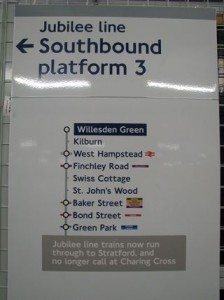
2. Find Your Correct Direction
In general, the Underground lines operate going north-south or east-west and vice versa.
Checking on your map will help you determine which direction you are travelling in, which will help you find the correct platform and train for your journey.
At every station, there will be maps like these showing the two directions that the trains will be travelling in, and under each direction will be a list of all the stations the train will stop at – in order!
This makes it easy not only to see which platform you need to be on but also how many stops it will take you to get to your destination.
3. Don't Board the Wrong Train
Sometimes, multiple Underground lines share the same track at a station. If you aren't paying attention, you could board the wrong train.
As the trains pull into the platform, you can take a glance at the front of the train. Here will be displayed the final destination of that particular train.
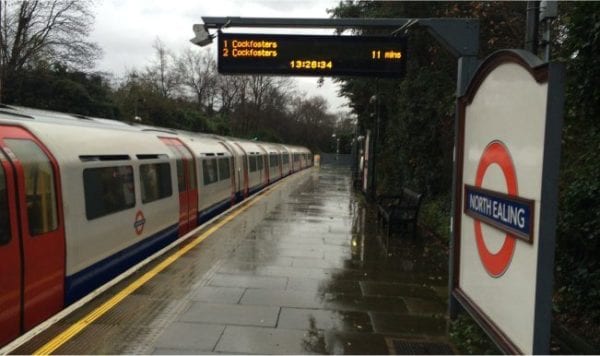
Also, on every platform there will be an electronic sign displaying the time until the next train arrives, and which station will be its’ final stop.
4. Lines that Split
Another potential mixup is lines that split. Some lines can have 2 or 3 different ending tracks, so you need to be aware of this.
Take the image below as an example.
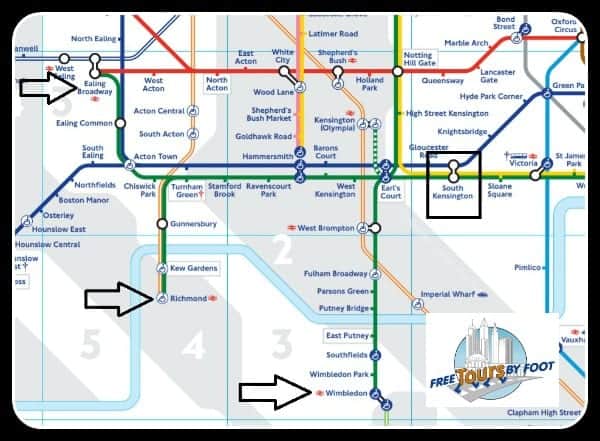
For example, suppose you plan on boarding a District Line (green) train at South Kensington Station (the black square) with a final destination Wimbledon (the bottom-most black arrow).
You would be taking a westbound train.
However, you can see from the map that there are two additional tracks with different ending points (Richmond and Ealing Broadway), all a part of the District Line heading westbound.
As you probably can tell, you could end up missing the first tennis match.
5. Changing Lines
The Tube map can often be misleading in that many tube lines crisscross over each other on the map, but do not actually connect to one another in reality.
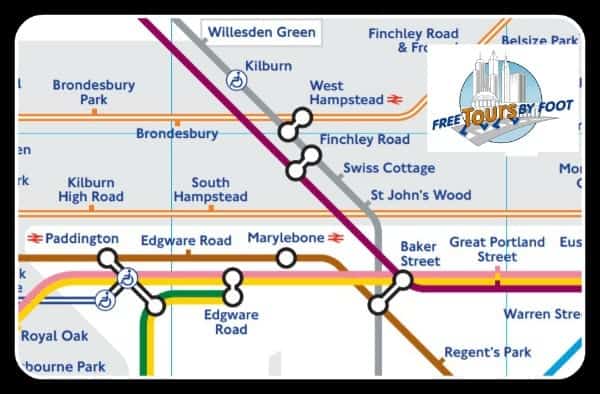
If you want to know where you can change from one Tube line to the other, you need to look for the white circle on the line on your map.
Any time you see one of these, it means you can change from one line to another or to British Rail.
Check out our tips on using the Underground with luggage and kids .
6. Sometimes You Should Just Walk
The London Underground Map is definitely NOT geographically accurate. Oftentimes it is easier to walk instead of getting on the tube to travel just a stop or two.
There is a map that gives the walking times between stations ( pdf ).
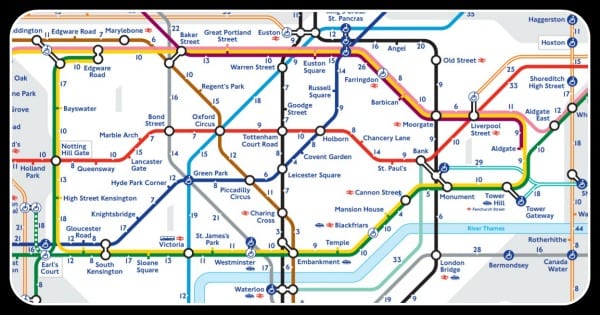
A good example of this is Leicester Square and Covent Garden on the Piccadilly Line.
On the map, they appear a fair distance apart, but in reality, it would take you just 4 minutes to walk the journey yourself.
Another good example is Charing Cross and Embankment - it’s just a 2-minute walk from each station!
7. Step-Free (Handicap) Access
For those with limited mobility, there are clues on the Underground map that will let you know if there is step-free access.
This is also useful if you are travelling with exceptionally heavy suitcases.
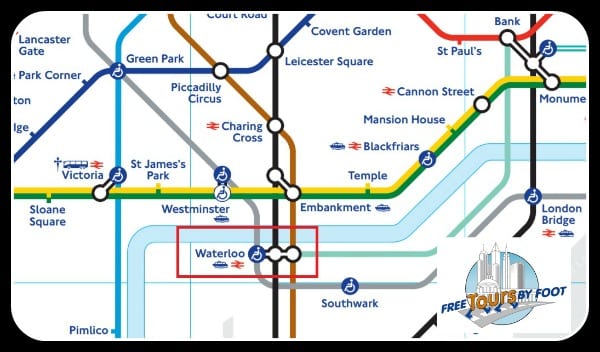
Simply look at the map, and on some stations, you will see a blue circle with a white figure in a wheelchair.
This means it is possible to get from the street into the train without any stairs or escalators.

The white circle and a blue figure in a wheelchair denote stations with step-free access from the street to the platform.
At these stations, you will need assistance to get into and out of the train, either with a ramp or the help of fellow passengers.
Note that in larger stations, such as Waterloo, the blue circle appears on one line only, which means the other two lines do not have step-free access. Transport for London has this helpful video .
A final note – Although London is generally a safe and welcoming city for visitors, pickpockets, and thieves operate throughout the entire London Underground network.
Please be aware of your surroundings, keep hold of all of your possessions, and avoid the habit of simply putting your ticket/credit cards/keys/mobile phones into your pockets – this will make you an incredibly easy target!
Also, never leave your belongings unattended on a train or in an Underground Station.
PICADILLY LINE TO AND FROM HEATHROW
By far the easiest and most affordable way to get to and from Heathrow Airport.
The Piccadilly Line runs through all 5 terminals of Heathrow Airport as well as straight through the centre of London, offering connections with every other tube line on the London Underground network.
Use our Google Map and input the address of your final destination for directions and travel time from Heathrow .
Travel time on the Tube is roughly 45 minutes to central London.
Piccadilly line trains run out of Heathrow from 5:00 to 23:00.
Ticket prices from Zone 1 to Heathrow are £6.70 for a cash-bought paper ticket, £5.60 on an Oyster card or contactless card at any time.
Read our full post on taking the Picadilly Line to and from Heathrow Airport .
TUBE ETIQUETTE
To avoid faux pas and keep from being marked out as a typical tourist, here are a few tips for Tube etiquette when travelling along the Tube.

1. Have Your Ticket Ready
Do not approach the ticket barriers until you have your Oystercard – or paper ticket – ready.
If you walk to the barrier and then fumble through your pockets/bags for your ticket, it will delay other travellers and oftentimes can mess with the barrier censors, potentially causing the barriers to lock.
[Remember you need a ticket both to BEGIN/ENTER and also to FINISH/LEAVE your journey!] Be sure to read our blog post on the Oystercard and Travel Card .
2. Stand on the Right
When riding escalators up and down in Underground Stations, please remember to stand on the RIGHT.
Travellers who wish to move up/down whilst on the escalators will be doing so on the left-hand side.
If you stand on the left you may find yourself politely asked to move to the right, or simply shoved past by a multitude of commuters.
This also includes your belongings/suitcases – they must be on the right of the escalators as well.
It is poor form and bad manners to take up the left side of the escalator with your belongings.
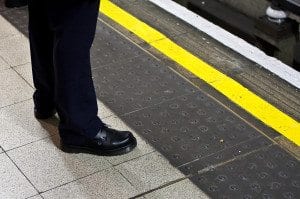
3. Stand Behind the Yellow Line
On every Tube platform, you will find a yellow line painted along the edge.
This line marks the boundary between where it is safe to stand, and where it is dangerous.
Stand BEHIND the line (not on top of!) in order to limit any risk of death or injury.
You may occasionally see passengers swiftly walking down the platform directly on top of the yellow line – but do not follow their lead!
4. Move Down the Platform
As soon as you get onto the platform, move either right or left.
You will find many people gathered at the entrance to the platform, meaning people cannot get past them and move onto the platform to get their train.
TIP : Besides just being courteous, the rear and front of the trains tend to be less crowded so moving down the platform means you’re more likely to get a seat!

5. Let Other Passengers Off First
As soon as the Tube doors open, step to either side of the opening doors and let customers off the train before you attempt to board.
Failure to follow this rule may lead to verbal chastisement.
6. Move Down Inside the Carriage
Once you are inside the Tube – move away from the door! Standing in place will impede others who are trying to board.
Also (especially during peak times) it is important to move as far down into the carriage as possible in order for the maximum amount of people to fit onto the train.
You will see Londoners standing in between the benches on busy Tube carriages, and you should follow their lead.
7. Keep Feet and Bags Off the Seats
Particularly on crowded trains, it is unacceptable to take up an entire seat solely for your possessions – or your feet!
8. Do Not Lean on the Poles
The poles that are placed throughout the Underground train carriages are meant for people to hold on to.
Leaning against one of the poles means blocking the pole for those that may need it to hold balance whilst the train is moving.
9. Mind Your Earphones and Your Meals
The music you are listening to should not be loud enough for anybody else on the Tube to hear.
Also, it is best to avoid eating hot/smelly food on the Underground.
10. Get Out of the Way of Those Getting Off the Train
When you are on the Tube and at a stop that is not yours, make sure you are not in the way of those who are trying to exit the train.
Occasionally, you may need to step outside of the train to let passengers off if the carriage is very crowded.
This is expected behaviour, and you will be able to step right back on once the departing have left.
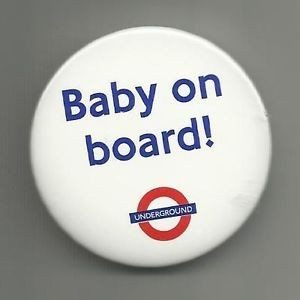
11. Stand Up for the Elderly and Pregnant
This is one even some Underground regulars need reminding of!
It’s just good manners in the UK to offer up your seat to the elderly, pregnant, or those who are less able to stand.
Be aware of who comes on the Tube at each stop and do not be afraid to offer your seat.
Occasionally you may see women with a small ‘Baby on Board’ badge with the London Underground logo pinned onto their coats.
Some men even take it upon themselves to stand up for any woman who comes onto the train so chivalry is not completely dead in London!
12. Take Your Rubbish Home With You
Rubbish left behind on the Tube is unsightly and can be quite disgusting.
There are no bins on Underground trains or at most Underground Stations which means it is expected that you will take any rubbish of yours off the train and home/back to your hotel with you when you leave.
On the London Underground, a little bit of courtesy and kindness can go a long way.
Commuting and travelling in the city can be quite stressful so try to remain courteous to others as you go about their business, and hopefully, they will do the same as you go about yours
HOP-ON-HOP-OFF BUS VS. LONDON UNDERGROUND
If you’re visiting London and aren’t sure about riding the London Underground, then we hope our tips above have made you more confident and willing to use the tube to get around town.
However, we understand that some people may still be a little anxious or unsure about the benefits of taking the tube, as opposed to riding one of London’s hop-on-hop-off tour buses.
To help you make up your mind, we’ve listed a few pros and cons of each below.

Hop-on-hop-off buses can be useful in getting an overview of the city or learning your way around town.
They are also quite useful for people who aren’t physically fit enough to walk through London day in and day out.
However, whenever possible, we strongly believe that the best - and the quickest - way to get around town is by taking the London Underground or to walk.
[Note that if you wish to take a hop-on-hop-off bus tour, we have a handy page HERE to help you choose which one to ride]
Pros of a Bus Tour
- easy to understand routes
- convenient stops at the most popular tourist attractions
- climate controlled all year (on the inside)
- tickets often include night tours, boat cruises, or free attractions.
- commentary along the routes
Cons of a Bus Tour
- more expensive than riding the subway
- routes are only one-direction
- wait times can be very long due to seasonal or even daily traffic
- buses can be crowded
- bad weather is always a risk
Pros of Riding the Underground
- (relatively) inexpensive
- flexible routing
- very warm in the winter
- you get to travel like a real Londoner
- Almost always faster than a bus
Cons of Riding the Underground
- not all stations are accessible for wheelchairs and strollers
- can be really hot and sweaty in summer
- can be really crowded during rush hours
- no commentary
Related Content
- Which Oystercard to Buy
- How to Get from Heathrow to London Centre by Underground
- How to Get from London to Paris by Train
- Things to do in London
- Most Haunted Places in London
Choose a Destination... I want them all PLUS general travel tips. Amsterdam Berlin Boston Charleston Chicago Dubai Lisbon London Los Angeles Miami Nashville New York City New Orleans Paris Philadelphia Prague Rome San Francisco Washington DC
About The Author

North America
United kingdom & ireland, middle east & india, asia & oceania.
Type and hit Enter to search
Latest news, the chaotic charm of fawlty towers returns to london, the wild side of harrods’ history: the exotic pet shop, explore london’s iconic river in style: the thames river cruise experience awaits, fresh view from the london eye, the piccadilly line – the best 5 spots along the dark blue tube line.
Editorial & Affiliate Disclaimer: Opinions expressed here are the author’s alone. Since I share great London activities with awesome people like you, naturally, my content may contain affiliate links for products, shows, tours, and other activities I do and love. Take action (i.e., subscribe, make a purchase); after clicking one of these links, I’ll earn some coffee money I promise to drink while creating more helpful content like this.
The Piccadilly Line is not only a great tube service, but also a great way to explore the city from the surface, simply using the stops as a template. If you get on at any of the Piccadilly Line stops, you can see some of London’s best attractions at each stop. Just choose which one is most attractive and then either walk or bike the Piccadilly route and notice not only how the city fits together, but often how close different stops are to each other.
Piccadilly Circus
Of course, we start at Piccadilly Circus, which is not only home to some excellent Piccadilly Circus hotels, but also a wealth of entertainment and activities. Here you’ll have the chance to see the famous LED-lit billboards that have been a London attraction for a hundred years and a historically significant starting point for the world of advertising in London, but also in the UK as a whole. At #1 Piccadilly Circus, you’ll find the Body Worlds Museum, which has taken the place of the Ripley’s Believe It Or Not Museum, which was there from 2008 to 2017 – certainly a good inning! Now in its place is an equally remarkable museum that offers visitors to London the chance to see how their own bodies work.
Address: 1 Piccadilly Circus, West End, London W1J 0DA
Leicester Square
A few steps down the street from Piccadilly Circus you’ll find Leicester Square, which has been London’s theater hotspot since 1670 and has been putting on great shows every night of the week ever since. Perfect for a meal, a show, or a meal and a show, Leicester Square forms the epicenter of what is affectionately called London’s “Theaterland.” Some shows currently running include (but are not limited to): Phantom of the Opera *, The Book of Mormon *, Mrs. Doughtfire* , Harry Potter and the Cursed Child* , Wicked* , Moulin Rouge* , and more. If you’re more into music, bars, and nightlife than food or theater, you’ve come to the right place, too: Nightclubs, bars, casinos… Leicester Square has it all and sparkles brightest in the evening.
Covent Garden
As soon as you start walking between Piccadilly, Leicester Square, Covent Garden, and the like, you’ll realize how close all these sights are and that although each one seems so concise and self-contained this description could apply to any single area. However, Covent Garden is undeniably a fabulous shopping destination. The Yards house the majority of Covent Garden’s shopping and are essentially an outdoor mall with numerous stores along the cobblestone streets of a bygone era when the once bustling market streets were filled with fresh flowers and cockleshells.
Address: The Yards 17 Slingsby Place St Martin’s Courtyard, London WC2E 9AB.
King’s Cross St Pancras
Let’s go a little further north, away from the central Piccadilly Line heartbeat, but still close. King’s Cross was once an area tourists wouldn’t have thought to visit: it was very industrial and once the best attraction was the train station (which, to be honest, is pretty big). Today, you could spend a whole day exploring the area. On Platform 9 ¾ the Harry Potter store and the famous trolley-in-the-wall setup where all the Potterheads line up to snap a new photo for their Instagram profile. One employee even holds their house scarf (which they couldn’t resist in the store before) out of the shot, making it look like they’re about to walk right through the wall.
Harry Potter* is of little interest to you? Alternatively, you can go shopping at Coal Drops Yard, which is a prime example of how far the area has come. Located in a converted, industrial Great Northern Western freight yard built in 1851, it’s now a hubspot for independent stores and quirky coffee shops. Simply put, it’s very “hipster.”
Art travelers who prefer a good exhibition to retail therapy can visit the House of Illustration, which features a number of temporary exhibitions, as well as the permanent Quentin Blake exhibit. Book lovers may have been so inspired by the works of Blake, whose illustrations lit up the world of Roald Dahl, that they may want to walk from Granary Square, where the House of Illustration sits, along Regent’s Towpath, which runs alongside Regent’s Canal to cross over to Word on the Water. Word on the Water is a floating bookstore on a barge and not only makes existing book dreams come true but also creates new ones.
South Kensington
Back south and on the other side, South Kensington lies below Hyde Park, waiting for visitors to discover the wonders of the area. However, the obvious remains: the museums, such as the Natural History Museum, the V&A Museum, and the Science Museum, likewise there is also a wonderful cafe environment with small bakeries and cafes scattered along a village-like area with extravagant houses and beautiful architecture. Dinosaur lovers will be happy at the museum, book lovers will be happy at the South Kensington Bookshop, a wonderful indie bookstore that does the area proud, and foodies will anchor at 2-star Michelin chef Claude Bosis’ restaurant in Bibendum.
Have you seen everything on the Piccadilly Route yet?
Share Article
Meet Sascha, who fell in love with London many years ago and has made it his mission to share his passion for the city with the world. Sascha is a London Expert who has spent years exploring every corner of the city, from its famous landmarks to its hidden gems. He now uses his expertise to help travelers plan their perfect London vacations, offering tips and advice on everything from the best restaurants and hotels to the most interesting neighborhoods and cultural experiences.
Other Articles
The story behind dirty dick’s, this is why london is a halloween hotspot, related posts, explore london like never before: unmissable adventures await at 50% off, embarking on a first-time adventure in london, london’s april 2024 extravaganza, unlock summer splendor: exclusive buckingham palace east wing tours.

TfL this weekend May 3 to 5: Underground, Overground and Elizabeth line disruption
Here is the full list of planned TfL service changes this weekend, May 3 to 5.
Londoners travelling into the capital this weekend could be faced with disruption due to closures on Tube and rail services.
Transport for London (TfL) has asked Londoners to check before they travel.
To get the most latest updates on the Underground, DLR and Overground you can use the TfL app or website.
Join our new WhatsApp Community to get the latest news from across London directly to your phone
London Underground
Oxford circus station strike.
From 10pm on Friday 3 until 6am on Sunday May 5, Oxford Circus station may need to close at short notice due to RMT strike action.
Customers should plan ahead and check before they travel for the latest information on how services are running.
Central line
Saturday May 4
Trains will not stop at Notting Hill Gate station between 1.45am and 3.15am
Use local bus routes 94, 148 or N207 to/from Queensway and Holland Park stations. This is due to track works on the station's Circle and District line platforms.
Ongoing disruption
TfL has apologised for the continued disruption on the Central line. It says engineers are working round the clock to address the issues, efforts which have “helped deliver a more reliable service, while ensuring the safety of our customers and colleagues”.
TfL asks that people plan ahead, allow more time for your journey and consider alternative routes if travelling on the Central line into or through central London.
Circle line
Saturday 4 until Monday May 6
No service between Tower Hill and Edgware Road (via Victoria)
Circle line trains will run between Hammersmith and Tower Hill via Moorgate. Use alternative Tube services or local bus routes. This is due to track works.
District line
No service between Embankment/Edgware Road and Hammersmith/Kensington (Olympia)/Wimbledon
Use alternative Tube services or local bus routes. Rail replacement buses will run between Hammersmith/Earl's Court and Wimbledon. This is due to track works.
Piccadilly line
Trains will not stop at Gloucester Road station including Night Tube services
Use local bus route 74 (N74 or N97 during Night Tube hours) to/from South Kensington or Earl's Court stations to connect with the Piccadilly line. This is due to track works.
London Overground
The following closures are due to Network Rail maintenance work.
Sunday May 5
No service between Camden Road and Stratford after 10.15pm
Use alternative Tube services or local bus routes. For Caledonian Road & Barnsbury, use local bus route 274 to/from Camden Road, or it is a short walk to/from Highbury & Islington. Rail replacement buses will run.
No service between Highbury & Islington and Dalston Junction after 10.15pm
Use local bus route 30. Rail replacement buses will run.
Elizabeth line
Monday May 6
A Saturday service will run on the entire line
Monday 6 until Wednesday May 8
Reduced service between Paddington and Maidenhead/Heathrow T4 after 10pm each night
Trains will not be stopping at Acton Main Line, West Ealing and Hanwell after 11pm each night. This is due to Network Rail track renewal works.
No service between Westferry/Poplar and Lewisham
Use alternative Tube or Southeastern rail services, or local bus routes. Rail replacement buses will run between Westferry and Island Gardens, and between Canada Water bus station and Lewisham.
London Trams
Sunday 5 until Thursday May 9
Planned strike action on London Trams network
If the strike action goes ahead:
A normal service is expected on Sunday.
Between Monday 6 and Wednesday May 8:
No service is expected before 7am or after 6pm each day
Between 7am and 6pm each day, services will only operate between:
- Wimbledon and Reeves Corner
- East Croydon and Beckenham Junction/New Addington
There will be no service through Croydon town centre, or to/from Elmers End on these days
Services are expected to start later than normal on Thursday 9 May, with possible disruption throughout the day.
TfL has asked customers to plan ahead, allow more time for your journey and check before you travel.
Buses and roads
Pembroke road.
Until 11.59pm on Saturday May 18, Pembroke Road will be closed in both directions at the junction of Warwick Road. Plan ahead and allow more time for your journey.
Thursday May 2
From 6.30pm until 10.30pm, the O2 Arena will host A Boogie Wit Da Hoodie in concert. Large crowds and increased traffic levels are expected before and after the event.
Stamford Bridge stadium
From 6pm until 10pm, Stamford Bridge will be hosting a football match between Chelsea and Tottenham Hotspur, with kick off at 7.30pm. Large crowds and increased traffic levels are expected before and after the match.
Friday May 3
From 6.30pm until 10.30pm, the O2 Arena will host Jo Koy. Large crowds and increased traffic levels are expected before and after the event.
Drumsheds, Tottenham Hale
From 12pm until 10.30pm, a concert will take place at Drumsheds. Large crowds are expected at the beginning and end of the event.
Twickenham Stadium
From 1pm until 7pm, Twickenham Stadium will host the Army vs Navy rugby matches, with the first game kicking off at 2pm and the second kicking off at 4.45pm. Large crowds and increased traffic levels are expected before and after each match.
From 6.30pm until 10.30pm, the O2 Arena will host Peter Kay Live. Large crowds and increased traffic levels are expected before and after the event.
Trafalgar Square
From 12pm until 3pm, a demonstration will take place at Trafalgar Square. Large crowds are expected.
From 9pm on Friday 10 until 6am on Monday May 13, the M25 will be closed in both directions between junctions 9 and 10. This is so that National Highways can carry out major motorway works.
During this closure, long delays are expected in Chessington, Epsom and Tadworth. Drivers should avoid driving through the area and consider alternative options.
If you have to drive, allow more time for your journey, consider alternative routes and check before you travel. For more information, visit the National Highways website.
Edgware bus station and Station Road
From 9pm until 5am each night, expect delays and diversions on bus routes that normally stop along Station Road in Edgware or at Edgware bus station. This is due to Thames Water works on Station Road between the A5 High Street and Hale Lane.
The bus station will remain open, but your journey may take longer as only one lane will be available to enter and exit the bus station.
Stops A and B on Station Road will be closed between 9pm and 5am each night on Friday 10 and Saturday May 11, while stops H, L and K on Station Road will be closed from Saturday 11 until Monday May 13.

- Share full article
For more audio journalism and storytelling, download New York Times Audio , a new iOS app available for news subscribers.

- May 19, 2024 The Sunday Read: ‘Why Did This Guy Put a Song About Me on Spotify?’
- May 17, 2024 • 51:10 The Campus Protesters Explain Themselves
- May 16, 2024 • 30:47 The Make-or-Break Testimony of Michael Cohen
- May 15, 2024 • 27:03 The Possible Collapse of the U.S. Home Insurance System
- May 14, 2024 • 35:20 Voters Want Change. In Our Poll, They See It in Trump.
- May 13, 2024 • 27:46 How Biden Adopted Trump’s Trade War With China
- May 10, 2024 • 27:42 Stormy Daniels Takes the Stand
- May 9, 2024 • 34:42 One Strongman, One Billion Voters, and the Future of India
- May 8, 2024 • 28:28 A Plan to Remake the Middle East
- May 7, 2024 • 27:43 How Changing Ocean Temperatures Could Upend Life on Earth
- May 6, 2024 • 29:23 R.F.K. Jr.’s Battle to Get on the Ballot
- May 3, 2024 • 25:33 The Protesters and the President
The Sunday Read: ‘Why Did This Guy Put a Song About Me on Spotify?’
The answer involves a remarkable — and lucrative, and ridiculous — scheme to game the way we find music today..
By Brett Martin
Read by Eric Jason Martin
Produced by Adrienne Hurst and Aaron Esposito
Narration produced by Tanya Pérez and Krish Seenivasan
Edited by John Woo
Original music by Aaron Esposito
Engineered by Sophia Lanman and Devin Murphy
Listen and follow The Daily Apple Podcasts | Spotify
Have you heard the song “Brett Martin, You a Nice Man, Yes”?
Probably not. On Spotify, “Brett Martin, You a Nice Man, Yes” has not yet accumulated enough streams to even register a tally. Even Brett Martin, a contributing writer for The New York Times Magazine and the titular Nice Man, didn’t hear the 1 minute 14 second song until last summer, a full 11 years after it was uploaded by an artist credited as Papa Razzi and the Photogs.
When Martin stumbled on “Brett Martin, You a Nice Man, Yes,” he naturally assumed it was about a different, more famous Brett Martin: perhaps Brett Martin, the left-handed reliever who until recently played for the Texas Rangers; or Brett Martin, the legendary Australian squash player; or even Clara Brett Martin, the Canadian who in 1897 became the British Empire’s first female lawyer. Only when the singer began referencing details of stories that he made for public radio’s “This American Life” almost 20 years ago did he realize the song was actually about him. The song ended, “I really like you/Will you be my friend?/Will you call me on the phone?” Then it gave a phone number, with a New Hampshire area code.
So, he called.
There are a lot of ways to listen to ‘The Daily.’ Here’s how.
We want to hear from you. Tune in, and tell us what you think. Email us at [email protected] . Follow Michael Barbaro on X: @mikiebarb . And if you’re interested in advertising with The Daily, write to us at [email protected] .
Additional production for The Sunday Read was contributed by Isabella Anderson, Anna Diamond, Sarah Diamond, Elena Hecht, Emma Kehlbeck, Tanya Pérez, Frannie Carr Toth and Krish Seenivasan.
Advertisement

IMAGES
VIDEO
COMMENTS
Connects to Circle, Hammersmith & City, Metropolitan, Northern and Victoria Connects to National Rail. Caledonian Road Underground Station. Holloway Road Underground Station. Arsenal Underground Station. Finsbury Park Underground Station. Connects to Victoria Connects to National Rail.
PICCADILLY LINE: Saturday 18 and Sunday 19 May, no service between Acton Town and Uxbridge. Use Metropolitan line services between Rayners Lane and Uxbridge. ... Journeys Plan a journey and favourite it for quick access in the future. Places Choose postcodes, stations and places for quick journey planning. Close edit Favourites Favourite lines.
TfL fares frozen until March 2025. Find out more about fares. Plan your journey across the TfL network. Journey planner for Bus, Tube, London Overground, DLR, Elizabeth line, National Rail, Tram, River Bus, IFS Cloud Cable Car, Coach.
Plan a journey; Status updates; Travel information. Improvements & projects; Safety; Stations, stops & piers; Timetables; Transport accessibility; Visiting London ; Ways to get around. Buses; Coaches; Cycling; ... Piccadilly line timetable Please select a Piccadilly line start and end point.
The Piccadilly Line is a line of the London Underground network which crosses the town of London from the north to the west. It connects the Heathrow Airport and the town of Uxbridge in the western part of the Greater London to Cockfosters, in the north, through the city centre of the English capital city. Around 220,000,000 passengers use the ...
The Piccadilly line is a deep-level London Underground line running from the north to the west of London. ... a British Rail and London Transport joint planning committee published "A Railway Plan for London", which proposed a new tube railway, the Fleet line ... Journey times on the Piccadilly line are usually around an hour and a half.
Join us as we embark on a captivating journey along the Piccadilly Line, discovering its rich history, architectural wonders, and unrivalled connectivity. The Birth of an Icon: Origins and Evolution. The Piccadilly Line, a testament to London's engineering prowess, had its humble beginnings in the early 20th century. Officially opening in ...
The Piccadilly Line also boasts stations at Heathrow International Airport, offering the quickest transit option to Central London. Additionally, it passes near another key London landmark - Buckingham Palace. For visiting the Palace, alight at Hyde Park Corner station. List of Piccadilly Line maps. See the stations on the map below (May 2024).
TfL Piccadilly underground Service Alerts. Open the app to see more information about any active disruptions that may impact the Piccadilly underground schedule, such as detours, moved stops, trip cancellations, major delays, or other service changes to the underground route. The app also allows you to subscribe to receive notifications for any service alert issued by TfL so that you can plan ...
London Underground Piccadilly line. Route and times to stations Eastbound and Westbound. Real-time line status information. desktop ... London Underground, DLR and Overground route planner, stations, train times & line status. Route Planner. ... Route and Journey Times. Time Eastbound. Heathrow T5: Heathrow T4: Heathrow T123: 0:05: Hatton Cross ...
The first tube trains start running from around 5.00-5.30am. The last tube trains leave central London around 12.30am (see the Night Tube below). Most trains start at least an hour later on Sundays. The exact start and finish times vary according to each individual underground line. Posters at tube stations give the first and last train times ...
Track Plan of Western Extension of Piccadilly Line (1035-06-15) by London Passenger Transport BoardTfL Corporate Archives. The line was also extended to the west to South Harrow, Uxbridge, and Hounslow West. The journey from Uxbridge to Cockfosters was at the time the longest electric journey then operated by the Underground.
Travel time on the Tube is roughly 45 minutes to central London. Piccadilly line trains run out of Heathrow from 5:00 to 23:00. Ticket prices from Zone 1 to Heathrow are £6.70 for a cash-bought paper ticket, £5.60 on an Oyster card or contactless card at any time.
Full journey on the piccadilly line between Rayners Lane and Green Park. The view is (from the rear of the carriage facing out of the window with an interior...
The Piccadilly Line is not only a great tube service, but also a great way to explore the city from the surface, simply using the stops as a template. If you get on at any of the Piccadilly Line stops, you can see some of London's best attractions at each stop. Just choose which one […]
Plan a rail journey in the UK or Europe with our Journey Planner. Our Journey Planner will show you all the available options to get you from A to B. Enter your departure and arrival stations and our clever tool will show you all the relevant info, including: Train times. Direct and indirect services. Changes.
The most convenient 'Tube' or London Underground line to use for the journey between Kings Cross and Heathrow is the Piccadilly line. You can catch the Piccadilly line from Kings Cross, and it provides a direct route to Heathrow. The journey typically takes just over hour to complete, depending on which Heathrow Terminal you are heading to ...
The Piccadilly line accounts for more than 10% of all journeys on the Tube, with around 200 million trips annually (before the pandemic) between destinations across north and west London, Heathrow Airport, the West End and King's Cross/St Pancras International. ... Journeys Plan a journey and favourite it for quick access in the future. Places ...
TfL asks that people plan ahead, allow more time for your journey and consider alternative routes if travelling on the Central line into or through central London. Circle line Saturday 4 until ...
Piccadilly line timetable From: ... Journeys Plan a journey and favourite it for quick access in the future. Places Choose postcodes, stations and places for quick journey planning. Close edit Favourites Favourite lines. Done updating my favourites. Bakerloo. Central.
Piccadilly line. Saturday February 10. ... To travel southbound, plan ahead, check before you travel, use alternative river crossings and allow more time for your journey. To help you cross the river, the Woolwich Ferry will run a service every 15-20 minutes between 8am and 7pm. The Congestion Charge zone will be in operation as normal.
Listen and follow The Daily Apple Podcasts | Spotify. Have you heard the song "Brett Martin, You a Nice Man, Yes"? Probably not. On Spotify, "Brett Martin, You a Nice Man, Yes" has not yet ...